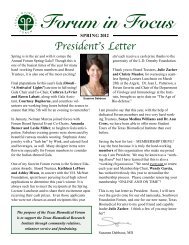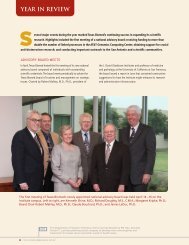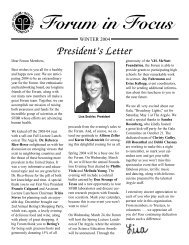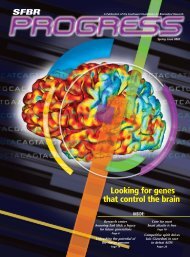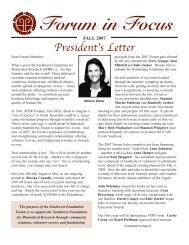Texas Biomed Science Report 2011-2012 - Texas Biomedical ...
Texas Biomed Science Report 2011-2012 - Texas Biomedical ...
Texas Biomed Science Report 2011-2012 - Texas Biomedical ...
You also want an ePaper? Increase the reach of your titles
YUMPU automatically turns print PDFs into web optimized ePapers that Google loves.
Robert A. Davey, Ph.D.<br />
Scientist, Virology and Immunology<br />
Drugs work together with vaccines to protect us against disease. Drugs<br />
are particularly effective for short to mid-term protection or when people<br />
are in areas where a recent outbreak has occurred or vaccination is not<br />
possible. Drug identification in the pharmaceutical industry has relied on<br />
testing large sets of chemicals, often in the millions, to block replication<br />
of virus or bacterial pathogens. After finding several thousand chemicals<br />
that work weakly, organic chemists modify and improve some of them<br />
to make more effective compounds and to ensure low toxicity and side<br />
effects to the patient. To handle so many chemicals is difficult and relies<br />
on robotics and other complex equipment. Unfortunately, this equipment<br />
is large, expensive and dangerous and requires continuous maintenance<br />
making it impractical to house in the high-containment laboratory.<br />
The BSL-4 maximum containment laboratory in the department of<br />
Virology and Immunology offers the perfect environment to develop and<br />
optimize an alternative workflow for identification of drugs for high<br />
containment pathogens. We have developed semi-automated approaches<br />
to drug screening that are safe, efficient and work at high containment.<br />
These include a microscope system that can automatically take photos of<br />
infected cells in 96 and 384-well plates as well as computer software that<br />
we have customized to automatically identify infected cells and determine<br />
drug efficacy. To ensure safety, our lab personnel are still heavily involved<br />
in hands on work but we can drastically reduce the time to finding<br />
effective drugs by 90 percent over more traditional methods by using this<br />
approach. Still, testing millions of chemicals would take a very long time<br />
but we have developed systems that can be used at low containment to<br />
Left to right: Manu Anantpadma,<br />
Janelle Bentz, Robert Davey,<br />
Robert Maldonado, Olena Shtanko<br />
<strong>2011</strong>–<strong>2012</strong> Scientific <strong>Report</strong><br />
“The fight against viral pathogens is ongoing and we cannot afford to let our guard down. We have dodged a<br />
number of bullets just over the last 10 years between naturally evolving and emergent pathogens as well as those<br />
made and released intentionally. The problem is that few facilities are capable of handling the type of pathogens<br />
that cause severe human disease, let alone to find drugs to combat them, because of the hazard posed to<br />
laboratory workers. My goal is to identify new drugs that can be used to combat these pathogens.”<br />
Staff<br />
Publications<br />
• Chen Z, Kolokoltsov AA, Wang J, Adhikary S, Lorinczi M, Elferink L, Davey RA (<strong>2011</strong>) GRB2<br />
interaction with the ecotropic murine leukemia virus receptor, mCAT-1, controls virus entry<br />
and is stimulated by virus binding. J Virol. Accepted for publication.<br />
• Eaves-Pyles T, Bu HF, Tan XD, Cong Y, Patel J, Davey RA, Strasser JE (<strong>2011</strong>) Luminal-applied<br />
flagellin is internalized by polarized intestinal epithelial cells and elicits immune responses<br />
via the TLR5 dependent mechanism. PLoS One 6:e24869.<br />
• Kolokoltsov AA, Adhikary S, Garver J, Johnson L, Davey RA, Vela EM (<strong>2011</strong>) Inhibition of<br />
Lassa virus and Ebola virus infection in host cells treated with the kinase inhibitors genistein<br />
and tyrphostin. Arch Virol Sep 25. [Epub ahead of print].<br />
• Kondratowicz AS, Lennemann NJ, Sinn PL, Davey RA, Hunt CL, Moller-Tank S, Meyerholz<br />
DK, Rennert P, Mullins RF, Brindley M, Sandersfeld LM, Quinn K, Weller M, McCray PB Jr,<br />
Chiorini J, Maury W (<strong>2011</strong>). T-cell immunoglobulin and mucin domain 1 (TIM-1) is a receptor<br />
for Zaire Ebolavirus and Lake Victoria Marburgvirus. Proc Natl Acad Sci USA, May 2.<br />
• Hunt, CL, Kolokoltsov AA, Davey RA, Maury W (2010) The Tyro3 receptor kinase Axl<br />
enhances macropinocytosis of Zaire ebolavirus. J Virol 85:334-47.<br />
• Saeed MF, Kolokoltsov AA, Albrecht T, Davey RA (2010) Cellular entry of Ebola virus<br />
involves uptake by a macropinocytosis-like mechanism and subsequent trafficking through<br />
early and late endosomes. PLoS Pathog 6 pii: e1001110.<br />
help narrow down targets to a few thousand chemicals which can be<br />
tested in a few weeks. Presently we are engaged in an ongoing project with<br />
a major drug screening facility at the National Institutes of Health. Our<br />
goal of this project is to identify new drugs against Marburg (cousin of<br />
Ebola virus) and Lassa fever viruses. The hits from this screen will be<br />
testing and optimized in the BSL-4 lab at <strong>Texas</strong> <strong>Biomed</strong>ical Research<br />
Institute. We are also working with other labs in the department to help<br />
analysis of data and assays and are already reaping the benefits in time<br />
and cost savings.<br />
E For more information, please visit www.txbiomed.org/departments/<br />
virology/virology-staff-bio?u=185<br />
25



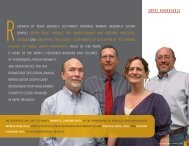
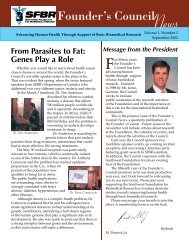
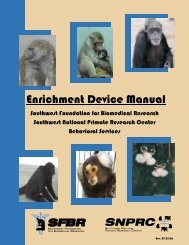
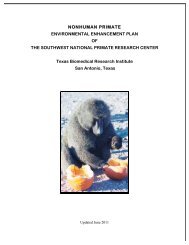
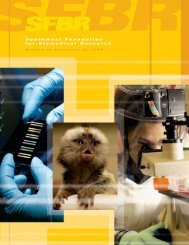
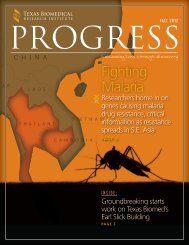
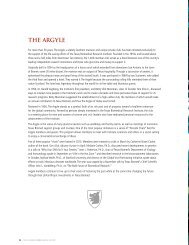
![Vol. 8 No. 2, 2011 [PDF] - Texas Biomedical Research Institute](https://img.yumpu.com/35688099/1/190x245/vol-8-no-2-2011-pdf-texas-biomedical-research-institute.jpg?quality=85)
